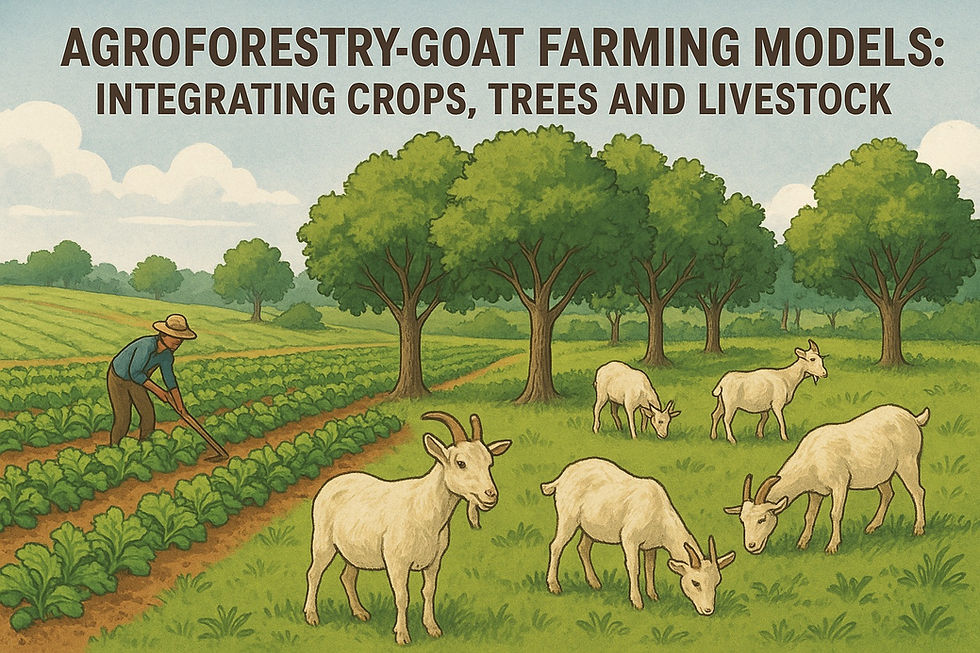Challenges in Goat Distribution & Best Ways to Minimize Risks in Distribution Programs in India
- Global Services TGT
- Dec 20, 2024
- 3 min read
Goat farming plays a significant role in improving rural livelihoods in India, particularly for small-scale farmers and marginalized communities. Goats are often termed the "poor man's cow" due to their adaptability, lower maintenance cost, and economic viability. Despite its potential, goat distribution programs in rural India face several challenges that hinder their effectiveness and sustainability. This article explores the key challenges in goat distribution and outlines measures to minimize associated risks.
Challenges in Goat Distribution Programs
Inadequate Infrastructure and Logistics: One of the primary challenges is the lack of proper transportation, holding facilities and health infrastructure in rural areas. Poor road connectivity and absence of dedicated goat transport systems can lead to delays, stress or even mortality of goats during transit.
Lack of Proper Health Management: Goats are susceptible to diseases such as PPR (Peste des Petits Ruminants), foot-and-mouth disease, and internal parasites. In many cases, distributed goats are not adequately vaccinated or dewormed before transportation. Poor health management increases the risk of disease outbreaks among the distributed livestock.
Quality and Selection of Breeds: The improper selection of goat breeds for specific agro-climatic zones reduces productivity. Distributed goats may not be well-suited to local conditions, leading to poor growth rates, higher mortality, and reduced economic returns for farmers.
Limited Training and Capacity Building: Most goat distribution programs fail to train beneficiaries in goat management, disease prevention,n, and improved practices. Without adequate knowledge, farmers are unable to maximize the potential benefits of their livestock.
Socio-Economic Challenges: In rural India, socio-economic factors such as landlessness, gender inequality, and caste-based discrimination can prevent fair distribution. In some cases, powerful individuals within the community may dominate the program, leading to inequitable access.
Lack of Monitoring and Follow-Up Mechanisms: A significant drawback in many goat distribution programs is the lack of proper monitoring and evaluation systems. Without follow-up visits, it becomes challenging to assess the impact, track goat health or provide further support when required.
Market Linkages and Value Chains: Farmers often struggle to access markets to sell their goats or goat products due to a lack of market linkages, poor road connectivity, and the absence of organized value chains. This impacts their income generation and discourages long-term engagement in goat farming.
Strategies to Minimize Risks in Goat Distribution Programs
Pre-Distribution Health Interventions
Vaccination and Deworming: Ensure that all goats are vaccinated, dewormed, and certified healthy before distribution.
Quarantine Practices: Implement temporary quarantine measures to prevent the spread of diseases during transportation and after delivery.
Breed Selection Based on Local Conditions
Identify and distribute goat breeds suited to specific agro-climatic conditions to ensure higher survival rates and productivity.
Engage local veterinarians and goat farming experts to make informed breed choices.
Robust Training and Capacity Building
Conduct pre-distribution training programs for beneficiaries on goat rearing, feeding practices, disease prevention, and general improved management.
Offer follow-up refresher training to ensure continued knowledge sharing and skill enhancement.
Improved Infrastructure and Logistics
Develop dedicated transportation facilities to minimize stress and mortality during transit.
Establish temporary holding facilities or goat shelters for safe distribution, especially in remote areas.
Improve road connectivity where feasible to facilitate goat transport and market access.
Transparent Selection and Distribution Process
Adopt a participatory approach to identify genuine beneficiaries, ensuring fair and equitable distribution.
Work with local governance bodies, self-help groups (SHGs), and NGOs to reduce socio-economic biases and ensure community ownership.
Post-Distribution Monitoring and Support
Implement regular follow-up visits to monitor goat health, growth, and reproduction rates.
Establish community-level support systems, such as veterinary health camps or Pashu Sakhies, to address farmers' issues promptly.
Collect data on program impact and beneficiary satisfaction to identify areas for improvement.
Strengthening Market Linkages
Facilitate access to organized markets and value chains to help farmers sell goats, milk, and related products at fair prices.
Encourage the formation of producer cooperatives or Farmer Producer Organizations (FPOs) to enhance bargaining power and improve income generation.
Promote goat-based enterprises such as meat processing, leatherwork, and dairy to create additional income opportunities.
While goat distribution programs have the potential to transform rural livelihoods, addressing the challenges is crucial for their long-term success. By focusing on pre-distribution health interventions, capacity building, transparent processes, and market development, stakeholders can minimize risks and ensure sustainable benefits for rural communities. Effective partnerships between government agencies, NGOs, veterinarians, and local communities will play a pivotal role in creating a robust and inclusive goat distribution ecosystem in India.
Through these measures, goat distribution can serve as a catalyst for poverty alleviation, women empowerment and rural economic growth in India.



Comments